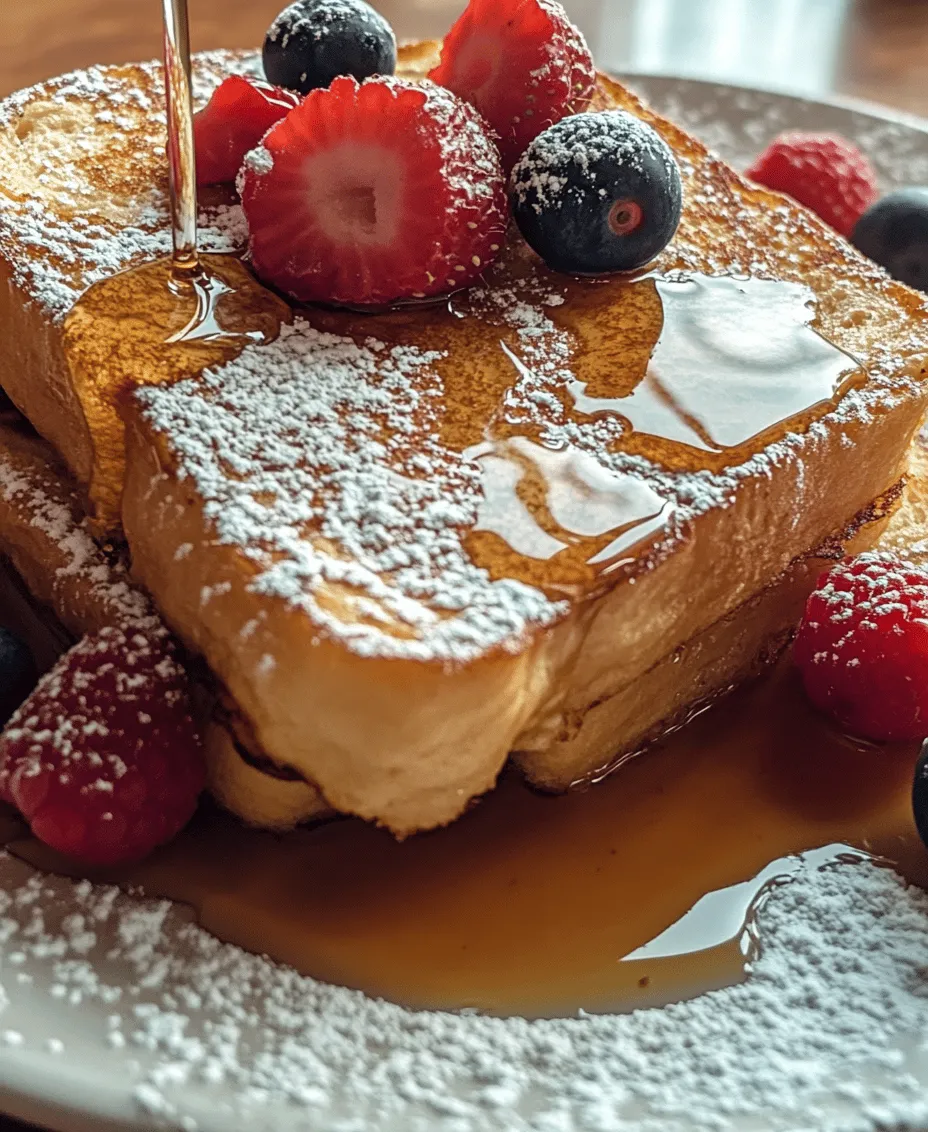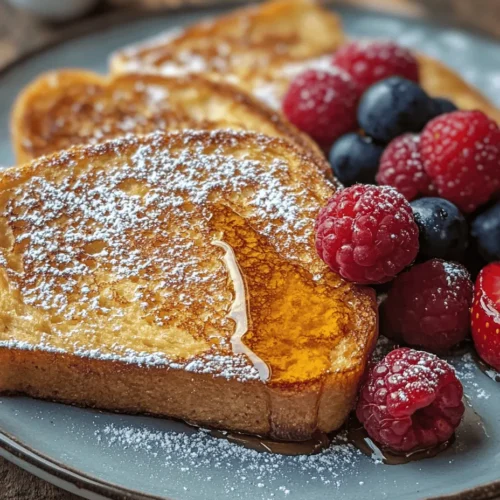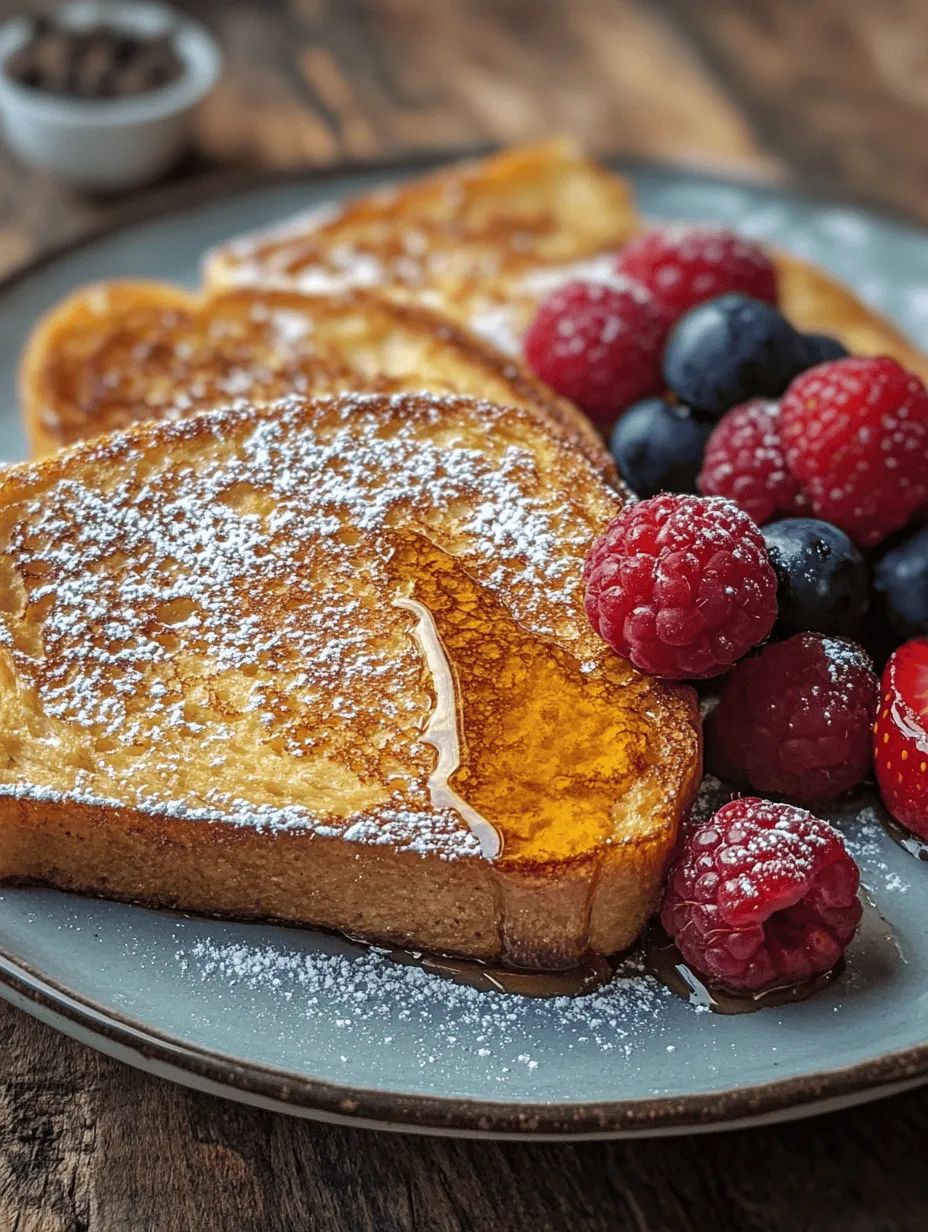Delightful French Toast Bliss is not just a breakfast dish; it’s a morning ritual that evokes the warmth of home and the simple pleasure of indulging in something sweet and satisfying. This classic recipe combines thick, fluffy bread with a rich, custardy texture that makes it a beloved choice for breakfast or brunch. When topped with maple syrup, fresh berries, and perhaps a dusting of powdered sugar, it transforms into a heavenly treat that can brighten anyone’s day. In this article, we will explore every aspect of making the perfect French toast, from selecting the right ingredients to mastering the cooking technique that will give you that delicious golden-brown finish.
Understanding the Ingredients of French Toast
To create the perfect French toast, it’s essential to understand the role that each ingredient plays in the overall flavor and texture of the dish. Let’s dive into the key components that make up this delightful breakfast staple.
The Foundation: Thick Bread Selection
The choice of bread is crucial for achieving the ideal French toast. Thick slices of bread not only provide a sturdy base but also allow for better absorption of the custard mixture. Here are some of the best options to consider:
– Brioche: This rich, buttery bread is a top choice for French toast due to its soft, fluffy texture and slightly sweet flavor. Its high egg and butter content means it soaks up the custard beautifully, resulting in a decadent breakfast experience.
– Challah: Similar to brioche but with a slightly denser structure, challah is another excellent option. Its slightly sweet flavor and airy texture make it perfect for soaking in the custard mixture, ensuring every bite is flavorful and satisfying.
– Texas Toast: If you’re looking for a more traditional option, thick-cut Texas toast can also yield great results. Its sturdy nature allows it to absorb the egg mixture well while maintaining its structure during cooking.
Choosing the right bread is not just about flavor; it directly impacts the consistency of your French toast. The thicker the bread, the more custard it can absorb without falling apart during the cooking process. Aim for slices that are at least three-quarters of an inch thick for the best results.
The Custard Mixture: Eggs and Milk
The custard mixture is the heart of French toast, and its primary components are eggs and milk.
– Eggs: The role of eggs in this recipe cannot be overstated. They provide the richness and structure necessary for a perfect French toast. When combined with milk, eggs create a creamy custard base that envelops the bread, resulting in a soft, custardy interior.
– Milk: Whole milk is the preferred choice for many French toast enthusiasts due to its creamy texture and ability to enhance the richness of the dish. It helps create a smooth custard that coats the bread evenly. For those looking for alternatives, options such as almond milk or oat milk can also be used, though they may alter the flavor slightly.
The balance between eggs and milk is essential; too many eggs can make the custard too rich, while too little can result in a dry texture. A common ratio is two eggs to one cup of milk, which yields a custard that is both creamy and flavorful.
Flavor Enhancements: Vanilla, Cinnamon, and Salt
To elevate the flavor profile of your French toast, consider adding a few enhancements:
– Vanilla Extract: A splash of pure vanilla extract adds depth and warmth to the custard mixture. It complements the sweetness of the bread and the syrup that will eventually top the finished dish. Aim for about a teaspoon per egg to achieve a balanced flavor.
– Ground Cinnamon: Cinnamon is a classic spice that brings a comforting, warm essence to the dish. It pairs beautifully with the sweetness of the syrup and the richness of the custard. A dash of ground cinnamon can transform your French toast into a fragrant breakfast delight.
– Pinch of Salt: While it may seem counterintuitive to add salt to a sweet dish, a small pinch is crucial for balancing flavors. Salt enhances the sweetness and richness of the custard, preventing it from becoming overly sweet and allowing other flavors to shine.
Step-by-Step Instructions for Perfect French Toast
Now that we’ve covered the ingredients, let’s move on to the preparation and cooking process. Follow these steps to create the perfect French toast that will delight your taste buds.
Preparation of the Egg Mixture
1. Gather Your Ingredients: Begin by assembling all your ingredients on the countertop. You’ll need eggs, whole milk, vanilla extract, ground cinnamon, and a pinch of salt, as well as your choice of thick bread.
2. Whisk Together: In a large mixing bowl, crack the desired number of eggs and add the milk. Use a whisk to blend them together until you achieve a uniform mixture. This is your custard base.
3. Add Flavorings: Once the eggs and milk are well-combined, add the vanilla extract, ground cinnamon, and a pinch of salt. Continue whisking until everything is thoroughly mixed. It’s important to achieve a smooth and homogenous mixture, as this ensures that the flavors are evenly distributed throughout the custard.
Cooking Techniques: Skillet vs. Griddle
When it comes to cooking your French toast, you have a couple of options: using a non-stick skillet or a griddle. Here’s a comparison to help you decide which method to use:
– Non-Stick Skillet: This is a common choice for cooking French toast. A skillet allows for better control over the cooking temperature and can be used for smaller batches. Make sure your skillet is preheated over medium heat before adding the bread, as this will help achieve that coveted golden-brown crust.
– Griddle: If you’re cooking for a crowd, a griddle may be the better option. It offers a larger cooking surface, allowing you to prepare multiple slices at once. Similar to a skillet, preheat the griddle to medium heat for uniform cooking.
Regardless of the cooking method you choose, maintaining optimal heat settings is crucial. Too high of a heat can lead to burnt exteriors and undercooked interiors, while too low may result in a soggy texture. Medium heat is typically the sweet spot for achieving a perfect golden-brown crust without compromising the custard inside.
Coating the Bread: The Dipping Process
The final step before cooking your French toast involves the dipping process, which is essential to ensure each slice is well-coated in the custard mixture.
1. Dip the Bread: Take a slice of your chosen bread and dip it into the custard mixture. Make sure to fully immerse it for a few seconds, allowing the bread to soak up the mixture. However, avoid letting it sit too long, as this can lead to overly soggy bread.
2. Let Excess Drip Off: After dipping, gently shake off any excess custard before placing the slice on your skillet or griddle. This step is crucial for preventing the bread from becoming too wet, which can affect the cooking process.
3. Repeat: Continue this process with the remaining slices of bread, ensuring each one is adequately coated and has excess custard removed.
With your bread coated and your cooking surface preheated, you’re now ready to move on to the cooking process, where the transformation from simple ingredients to Delightful French Toast Bliss will take place.
Stay tuned for the next section, where we will delve into the cooking techniques, toppings, and serving suggestions that will elevate your French toast experience.

Instructions for Dipping the Bread in the Custard Mixture
To create the perfect French Toast Bliss, the technique of dipping the bread slices in the custard mixture is crucial. Start by ensuring that your bread is adequately stale; day-old bread works best as it absorbs the custard without becoming overly soggy.
1. Prepare the Custard Mixture: Whisk together your eggs, milk, vanilla extract, and a pinch of salt in a shallow bowl. For added flavor, you can incorporate a dash of cinnamon or nutmeg. The mixture should be smooth and well combined.
2. Dipping Technique: Take one slice of bread and hold it at the edges. Submerge it gently into the custard mixture, ensuring that both sides are coated. Avoid letting the bread sit too long in the mixture; a quick dip of about 5 seconds on each side is ideal. This helps prevent sogginess while ensuring a delightful custard coating.
3. Draining Excess Custard: After dipping, allow the excess custard to drip off by holding the bread vertically for a moment. This step is vital for achieving an even coating without ending up with a soggy slice.
4. Repeat: Continue this process until all slices of bread are coated. If you are preparing multiple servings, it might be wise to dip in batches, keeping an eye on the custard level to ensure each slice gets a sufficient soak.
Tips for Avoiding Sogginess and Ensuring Even Coating
To achieve that perfect French toast, avoiding sogginess is essential. Here are some practical tips:
– Choose the Right Bread: Brioche, challah, and sourdough are excellent choices due to their density and ability to hold up against the custard without becoming overly wet.
– Use Stale Bread: The drier the bread, the better it will absorb the custard without becoming too soggy. If you only have fresh bread, consider lightly toasting it in the oven at a low temperature to dry it out before dipping.
– Moderate Custard Mixture: Ensure your custard mixture is not too liquid-heavy. A thicker custard will coat the bread better and prevent it from soaking through entirely.
– Quick Dips: As mentioned, quick dips in the custard are crucial. Aim for a couple of seconds on each side; you want a coating, not a soaked slice.
Cooking Time and Temperature
Achieving the perfect texture for your French toast requires attention to cooking time and temperature.
1. Preheat Your Pan: Prior to cooking, preheat a non-stick skillet or griddle over medium heat. You want it hot enough to give the toast a beautiful golden-brown color without burning.
2. Cooking Time: Each slice of French toast will typically need about 3 to 5 minutes per side. Keep an eye on the color; you’re looking for a rich golden hue. If you notice the toast browning too quickly, reduce the heat slightly.
3. Determining Doneness: French toast is done when it is golden brown on both sides and feels firm to the touch. You can also check the center by gently pressing down; it shouldn’t be mushy. An internal temperature of 160°F (71°C) is ideal for fully cooked eggs.
Serving Suggestions for French Toast Bliss
Now that your delightful French toast is ready, it’s time to think about how to serve it for maximum enjoyment.
Classic Toppings: Maple Syrup and Butter
Nothing beats the classic combination of warm maple syrup and a pat of butter melting on top of your French toast. Here are some points to consider:
– Flavor Profiles of Maple Syrup: Different maple syrup grades vary in flavor intensity. Grade A syrup is light and mild, while Grade B syrup is darker and has a more robust flavor. Choose according to your preference; experimenting with both can add depth to your French toast experience.
– Butter Choices: A good quality unsalted butter is recommended for its versatility and ability to enhance the flavors of the dish. Consider flavored butters, such as honey or cinnamon butter, for a unique twist.
Garnishing with Fresh Berries
Adding fresh berries not only enhances the visual appeal but also introduces a burst of flavor and nutritional benefits. Here’s what you can consider:
– Seasonal Berries: Strawberries, blueberries, raspberries, and blackberries are all fantastic options. Each berry offers a different taste profile; for example, strawberries are sweet, while raspberries provide a tart contrast.
– Nutritional Benefits: Berries are rich in antioxidants, vitamins, and dietary fiber, making them an excellent addition to your French toast. They can help balance the sweetness of the syrup and add a fresh element to the dish.
Optional Enhancements: Powdered Sugar and Other Toppings
To elevate your French toast, consider these optional enhancements:
– Dusting with Powdered Sugar: A light dusting of powdered sugar not only adds a touch of sweetness but also creates an elegant presentation. Use a fine sieve to achieve an even distribution.
– Alternative Toppings: Don’t shy away from other delicious toppings like whipped cream, yogurt, or even a dollop of mascarpone cheese. Each of these can add a creamy texture and a unique flavor that complements the French toast.
Nutritional Information and Serving Size
Understanding the nutritional content of your French toast can assist in making informed choices based on dietary needs.
Caloric Breakdown: A standard serving of French toast made with egg and milk contains approximately 250 to 350 calories, depending on the bread used and added toppings.
– Macronutrient Distribution: This dish typically provides about 12 grams of protein (depending on the egg and milk ratio), 30 grams of carbohydrates, and around 10 grams of fat when butter is included.
Serving Sizes: A practical serving size is two slices of French toast per person. However, you can adjust the portions based on your specific dietary goals—whether you want a lighter breakfast or a more indulgent treat.
Conclusion: Relishing the Simple Pleasure of French Toast
Delightful French Toast Bliss is more than just a recipe; it’s a celebration of simple ingredients coming together to create something extraordinary. Whether enjoyed on a lazy weekend morning or as a special treat during the week, this dish offers a nourishing start to the day and a moment of joy in every bite.
By understanding the nuances of the ingredients and the cooking process, anyone can recreate this classic dish with confidence and flair. Embrace the art of French toast and savor the bliss it brings, warming hearts and homes alike.



